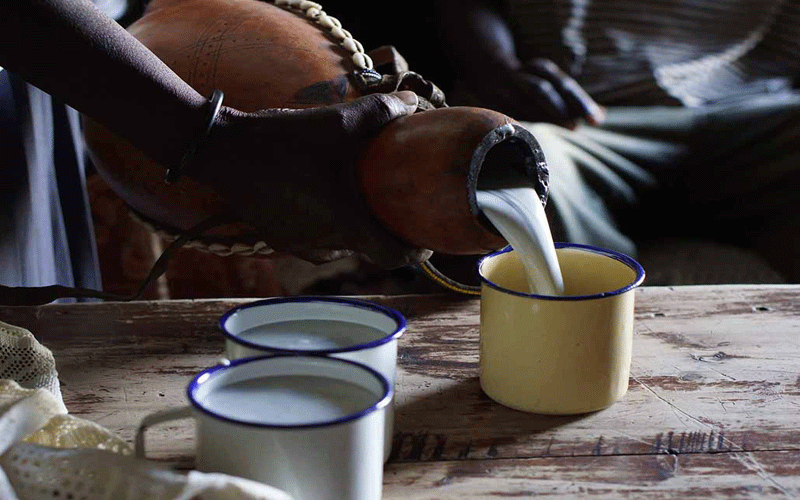Using traditional milk technology to boost health and make money
By Christopher Owuor, June 16, 2020
Mwangi Mumero
Whenever Kenya-award winning athletes return home from their exploits abroad, they are bound to get a sip or two of traditionally fermented milk—known as mursik—a popular dish among the Kalenjin community.
From Boston, New York and London Marathons, Kenya runners –mainly drawn from the Rift Valley— have made global headlines after winning numerous contests and huge sums of money in their wake.
And they have popularised mursik, made from an indigenous technology that spans over 300 years.
Prepared in traditional gourds, the milk is fermented and mixed with charcoal from a special tree- known as Peanut Butter Cassia (Senna dydimobotrya).
“Selected sticks from the Cassia tree are set alight and the burning amber pushed inside the gourd.
After heating the inside of the containers walls in a methodical fashion, the inside is covered with a fine dust.
Excess charcoal is then poured away,” says Charles Lang’at, a Bomet farmer and a regular producer of mursik for domestic use.
Local folklore has it that the charcoal adds flavour to the milk, strengthens the bones and increases longevity.
“Sap from the tree cures stomach upsets and neutralise acids during fermentation,” says Lorna Birir, a resident of Kipkelion’s Giri Mori Village.
“The charcoal strengthens bones. It is the secret behind longevity and the speed of our runners.
Modern yoghurt was developed as a result of the need to modernise mursik (called kule naoto in Maasai) and have different flavours,” she adds.
After the gourd is coated with charcoal dust, cooled boiled milk is poured in immediately and fermented for two to three weeks. Shaking twice a week makes it consistent and ferment well.
Depending on milk supplies, large quantities can be fermented by adding small amounts into the gourd.

The fermented milk provides the culture- yeast cells and enzymes- needed for the process of fermentation.
“Traditionally, the cow was milked directly into the treated gourd and the milk mixed with fresh blood and stored to ripen,” says Kipsang Bett, a rural extension officer formerly with Arid Lands Information Network, a local non-governmental organisation.
Environmental concerns
However, given modern demands for hygiene, blood is no longer added and the milk has to be boiled –pasteurized first, says Bett.
The Peanut Butter tree charcoal, the source of a groundnut-type flavour, has been used in this technology for generations.
Known as Senetwet in Kipsigis, Mwino in Kikuyu, Osenetoi among the Masaai, the shrub grows near cattle bomas and prefers well-drained soils, but can withstand drought as animals rarely feed on its leaves.
Conservations, however, lament that continuous use of this tree for milk fermentation endangers the tree species and may make it disappear completely.
Viable alternatives trees available to local pastoralists include Oleo Africana, Phus natalensis, Olea capensis, Acacia mearsii and Prunus africana.
The flavour of mursik (iria igagatu in Kikuyu) is determined by the quality of milk used, the technique of cleaning the gourd, time taken for the milk to be served and the tree species used to treat the gourd.
The stage of lactation of the cow, the cow’s diet and its breed also affect flavour.
Experts say extreme care must be taken during gourd treatment and milk fermentation process to ensure high hygienic standards to avoid potential food poisoning.
Research conducted by the Department of Food Science and Technology at the former Kenya Agriculture Research Institute (Kari) and Jomo Kenyatta University’s Department of Botany indicates that the stem charcoal of Senna didymobotrya inhibits the growth of microorganisms—the main causes of food poisoning and skin ailments
The study showed that the plant can be considered a viable substitute for the chemical preservatives. Health conscious consumers now prefer products preserved with non-synthetic compounds.
Even with its huge potential, the Peanut Butter Cassia tree remains wild and faces the danger of being cut down to extinction.
Apart from its major use as a milk preservative, the plant’s leaves, roots, bark and stem have a wide range of healing properties.
Commercialisation dangers
The World Agro-Forestry Centre (ICRAF) says that the plant has been used in Africa as a food additive and an anti-malarial for ages.
A decoction of the leaves is used for stomach complaints. Fresh roots and leaves treat abscesses of the skeletal muscles and venereal diseases, among others.
Further research in Congo, Rwanda, Burundi, Tanzania and some parts of Kenya has indicated that a concoction made from boiled roots and barks from the tree is used for the treatment of malaria and other fevers.
Commercialisation of this technology, however has ruined its value and rendered the ‘new mursik’ lack its traditional flavour.
“The taste, texture, colour and even thickness of mursik sold in the restaurants is no longer the same as what we used to have when we were young,” says Weldon Rotich, a resident of Nakuru.
Today’s mursik is sold in jerry cans- away from the traditional gourds – affecting its flavour. A litre of the commercial mursik retails at Sh80 to Sh120 depending on outlets.